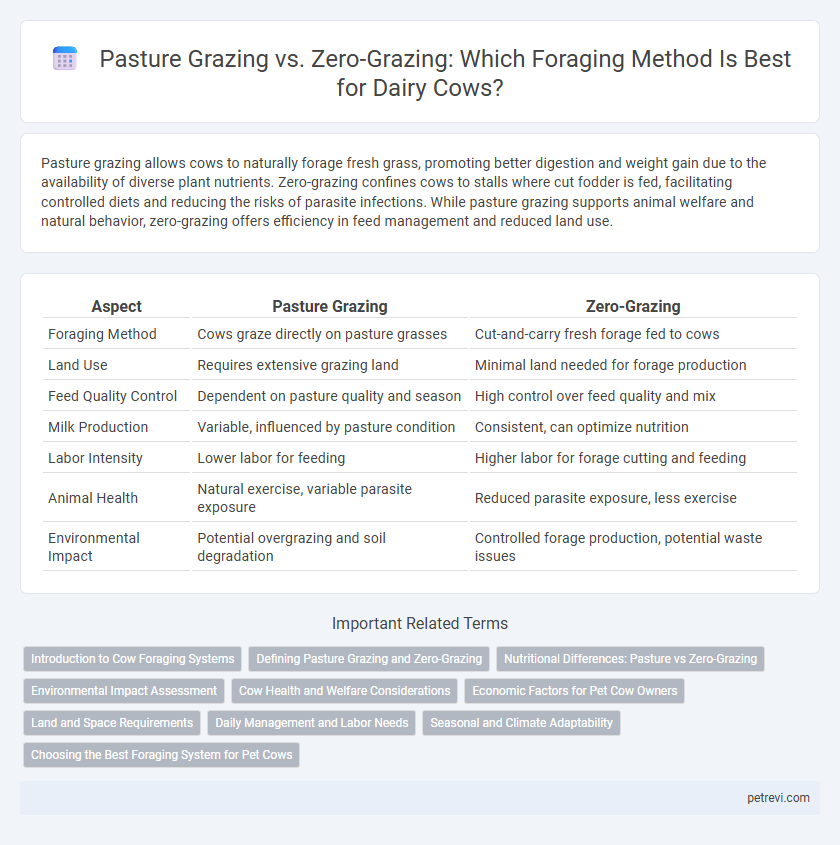Pasture grazing allows cows to naturally forage fresh grass, promoting better digestion and weight gain due to the availability of diverse plant nutrients. Zero-grazing confines cows to stalls where cut fodder is fed, facilitating controlled diets and reducing the risks of parasite infections. While pasture grazing supports animal welfare and natural behavior, zero-grazing offers efficiency in feed management and reduced land use.
Table of Comparison
| Aspect | Pasture Grazing | Zero-Grazing |
|---|---|---|
| Foraging Method | Cows graze directly on pasture grasses | Cut-and-carry fresh forage fed to cows |
| Land Use | Requires extensive grazing land | Minimal land needed for forage production |
| Feed Quality Control | Dependent on pasture quality and season | High control over feed quality and mix |
| Milk Production | Variable, influenced by pasture condition | Consistent, can optimize nutrition |
| Labor Intensity | Lower labor for feeding | Higher labor for forage cutting and feeding |
| Animal Health | Natural exercise, variable parasite exposure | Reduced parasite exposure, less exercise |
| Environmental Impact | Potential overgrazing and soil degradation | Controlled forage production, potential waste issues |
Introduction to Cow Foraging Systems
Pasture grazing allows cows to forage directly on natural grasslands, promoting natural behavior and access to diverse nutrients. Zero-grazing involves harvesting forage and delivering it to cows, enabling controlled diet management and reducing land requirements. Both systems impact milk production, animal health, and farm sustainability differently, making their choice critical for efficient dairy farming.
Defining Pasture Grazing and Zero-Grazing
Pasture grazing involves cows foraging directly on open grasslands, allowing natural intake of diverse plant species that enhance nutrient absorption and promote rumen health. Zero-grazing, also known as cut-and-carry, entails harvesting fresh forage and bringing it to confined cows, enabling precise control over diet quality, minimizing pasture degradation, and reducing parasitic infections. Each method impacts cow productivity and welfare differently, with pasture grazing supporting natural behaviors and zero-grazing optimizing feed efficiency under controlled conditions.
Nutritional Differences: Pasture vs Zero-Grazing
Pasture grazing offers cows access to diverse, nutrient-rich fresh grasses that enhance fiber intake and promote better rumen function, leading to improved digestion and milk quality. Zero-grazing relies on harvested forage like cut grass or silage, which can result in more controlled but sometimes less varied nutrient profiles, potentially affecting protein levels and energy availability. Nutritional differences between pasture grazing and zero-grazing significantly influence cow health, milk yield, and overall production efficiency.
Environmental Impact Assessment
Pasture grazing allows cows to forage naturally, promoting soil health through organic fertilizer deposition and supporting biodiversity, leading to lower carbon emissions per unit of milk produced. Zero-grazing confines cows indoors, requiring external feed production that often increases greenhouse gas emissions and land degradation due to intensive crop cultivation. Environmental Impact Assessments indicate pasture grazing generally offers a more sustainable and ecologically balanced approach for cow foraging compared to zero-grazing systems.
Cow Health and Welfare Considerations
Pasture grazing allows cows to express natural foraging behaviors, promoting better hoof health and reducing stress-related illnesses through increased physical activity and fresh air exposure. Zero-grazing limits movement, potentially leading to higher risks of lameness and digestive disorders due to confined conditions and less varied diet. Optimal cow health and welfare depend on balancing nutrient intake with space for natural behaviors, often favoring pasture-based systems for long-term well-being.
Economic Factors for Pet Cow Owners
Pasture grazing reduces feed costs by utilizing natural grass, making it an economical choice for pet cow owners with ample land. Zero-grazing involves purchasing or growing fodder, increasing expenses but allowing better control over diet and hygiene. Economic factors favor pasture grazing when land is available, while zero-grazing suits owners prioritizing quality feed despite higher costs.
Land and Space Requirements
Pasture grazing requires extensive land to provide ample space for cows to forage naturally, promoting healthier soil and biodiversity. Zero-grazing demands minimal land since cows are confined, relying on cut fodder transported to their shelter, which can optimize space in land-scarce areas. Grazing systems prioritize natural behaviors and land regeneration, whereas zero-grazing maximizes feed efficiency on limited land resources.
Daily Management and Labor Needs
Pasture grazing requires daily monitoring to manage rotational grazing schedules, forage availability, and animal health, demanding moderate labor efforts from farm workers. Zero-grazing involves cutting and transporting forage to cows in confinement, intensifying daily labor tasks like feed preparation, barn cleaning, and feed distribution. Efficient daily management in zero-grazing systems often necessitates higher labor input compared to pasture grazing, influencing farm operational costs.
Seasonal and Climate Adaptability
Pasture grazing allows cows to access fresh forage that changes seasonally, supporting better nutrient intake aligned with natural growth cycles, while zero-grazing systems provide controlled feed regardless of seasonal variations but may lack diversity in nutrients. In regions with unpredictable rainfall and temperature fluctuations, pasture grazing offers adaptability through diverse forage species, enhancing resilience to climate stress. Zero-grazing relies heavily on stored or imported feed, making it less flexible during extreme weather but beneficial for managing forage availability in consistently harsh climates or limited land areas.
Choosing the Best Foraging System for Pet Cows
Pasture grazing offers pet cows natural forage, promoting better digestion and exercise, while zero-grazing ensures controlled nutrition with higher-quality feed but requires more labor and resources. For pet cows, pasture grazing supports natural behaviors and mental well-being, whereas zero-grazing allows precise diet management and protection from parasites. Selecting the optimal foraging system depends on available land, labor capacity, and the cow's health needs to balance welfare and productivity.
Pasture grazing vs Zero-grazing for Cow foraging Infographic

 petrevi.com
petrevi.com